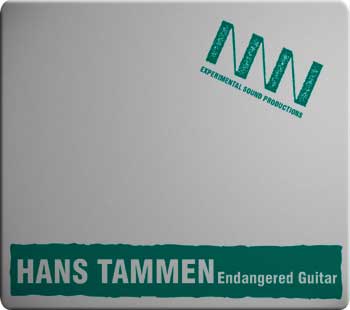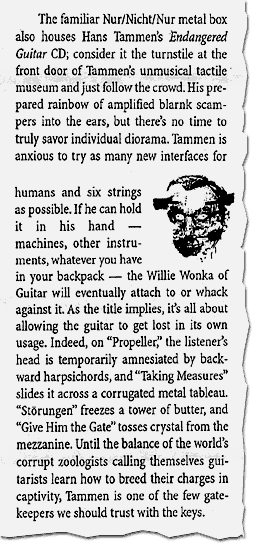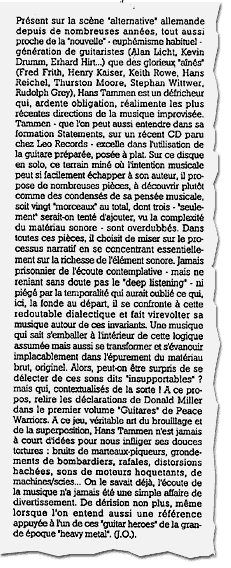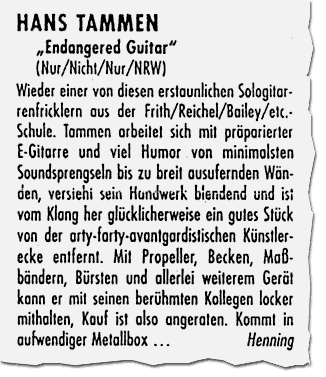
Siebentonmusik 08:00
Zwölftonmusik 08:27
Vier Flächen 08:10
Machine Code 08:22
Ohrenbetäubend 11:26

Bananafish 14

Peace Warriors 13

Lounge 8-99

Auf Abwegen 28
'A man has an electric guitar on his lap, and with an electric fan, which
usually cools off hot faces, coaxes fascinating growling sounds from
it. All this he
does with a satisfied grin.' This little review at the Hessisch-Niedersächsische
Allgemeine (June 9th, 1997) is used as the main description of Hans Tammen
works on this CD. Now since the days of industrial music where musicians as
Throbbing Gristle and Boyd Rice placed electric fans on their electric guitar
we are not keen on musicians who does the same today. As the industrialists
it does, noboddy else can do it better, we thought. But we may say that Hans
is doing it even better. The industrialists did it to make noise, Hans to produce
sounds and that is sommething completely different, even when he is able to
produce in some sounds that can be used in industrial music. But in other parts
of his music the sounds are fragile and becomes little pieces of avantgarde
music.
Besides the litlle electric fan he uses much more different materials such as
small stones, cymbals, bowed tin plates, and much more to produce several kind
of sounds. With from time to time the use of special electronic effects. the
result is a CD full of intimate sounds where the quality is stressed in the variety
of the sounds that goes from industrial tunes towards rythmical, ambient and
even sacral sounds.
Geert De Decker at Sztuka Fabryka
Nur/Nicht/Nur specialise in "experimental sound productions", and owner Dieter Schlensog has said that he is unsure whether what he releases on the label is music at all. Tammen certainly doesn't play tunes, if that's the sort of thing Schlensog is thinking of. Laying his guitar flat, he "plays" it with an electric fan, violin bows, stones, cymbals and the rest of the now rather familiar repertoire of guitar extentions. That kind of approach is often associated with a search for richness, a kaleidescopic range of timbral effects, employed in the interests of self-expression, which is, however, not what's happening here.
The very fact that this is a solo disc, with only three (out of twenty) tracks using overdubs, gives away some of the eremitic simplicity of his vision. These sounds don't create a nice sensual texture or a solo against an accompaniment. No, they stand on their own, as inscrutable as the little piles of stones in a Zen garden. It's no wonder the sleeve notes also refer to this as a "collection", a "catalogue" of sounds. But this is no dry technical handbook, no report of Tammen's sonic discoveries, or at least it's not simply that.
In order to understand this, one has to accept that there is an aesthetic of the catalogue, the unadorned list, the presentation of objects without narrative. Think of Perec's "La Vie, Mode d'Emploi", or the lists which proliferate in "Finnegans Wake", or think of Damian Hirst's sculptures like "Against the Tide" which collect objects and present them, as if in a museum, only stripped of any didactic intention or informational content. If there can be a beautiful elegance in the spartan collection and presentation of objects supposedly without style, without finesse, then that aesthetic also extends to Tammen's "Endangered Guitar", a lovely simplicity which, like all simplicity, is complexity in disguise.
The pieces themselves -- most of which are fairly short -- generally take a guitar setup and run with it, producing sounds and developing them in deceptively straightforward ways. The result is bewitching. What sounds as if it's going to be an okay-in-small-doses record, crammed as it is with fairly nasty scraping, piercing high frequencies and percussive noise, captivates you and won't let you turn it off. It's astringent, yes, but the clarity with which Tammen works infuses the whole thing with a lightness which just keeps you listening. In a year which has already seen quite a few really excellent solo guitar releases (Gilbert Isbin and Roger Smith, to name but two very recent ones) "Endangered Guitar" stands comfortably alongside them. Very highly recommended.
Richard Cochrane